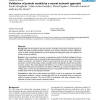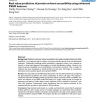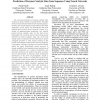6 search results - page 1 / 2 » Using neural networks and evolutionary information in decoy ... |
BMCBI
2008
13 years 4 months ago
2008
Background: We present a novel method of protein fold decoy discrimination using machine learning, more specifically using neural networks. Here, decoy discrimination is represent...
BMCBI
2008
13 years 4 months ago
2008
Background: The development and improvement of reliable computational methods designed to evaluate the quality of protein models is relevant in the context of protein structure re...
ISMB
2000
13 years 5 months ago
2000
Knowing the number of residue contacts in a protein is crucial for deriving constraints useful in modeling protein folding, protein structure, and/or scoring remote homology searc...
BMCBI
2008
13 years 4 months ago
2008
Background: Prediction of protein solvent accessibility, also called accessible surface area (ASA) prediction, is an important step for tertiary structure prediction directly from...
CIBCB
2007
IEEE
13 years 8 months ago
2007
IEEE
The accurate prediction of enzyme catalytic sites remains an open problem in bioinformatics. Recently, several structure-based methods have become popular; however, few robust seq...



